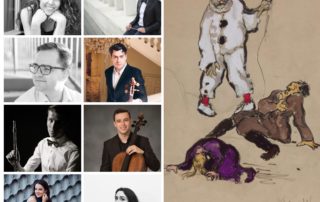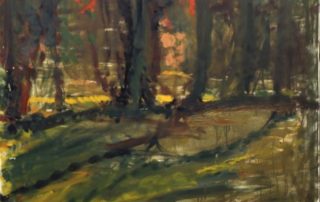Rachel Stern2022-04-28T09:33:15-04:00April 26th, 2022|Newsletter|
Dear Friends, Thursday is Yom HaShoah - Holocaust Memorial Day. In January, we invited you to actively commemorate victims of National Socialism by contributing to the Arolsen Archive’s digital memorial #EVERYNAMECOUNTS. I know that some of you found the project so meaningful that you are still donating your time to it. Right now, you can choose to enter data of documents from Buchenwald, Flossenbürg or Dachau: PARTICIPATE HERE This Thursday, I invite all to donate time to help build this important digital memorial. On our website you find further information about the project and our partnership with the Arolsen Archive: https://fritzaschersociety.org/digifas/everynamecounts/ And please share your experience with us! In May, we turn to the experience of [...]
Rachel Stern2022-03-28T05:26:02-04:00March 28th, 2022|Newsletter|
Dear Friends, When the artist Ben-Zion was born in 1897, his hometown Starokostiantyniv belonged to the Russian Empire. By the time he left for the United States, it belonged to the Ukraine/Poland. Today it again belongs to the Ukraine, and is brutally attacked and destroyed by the Russian army. As the casualties are mounting, we hope for peace, democracy and independence in the Ukraine. Join us on Wednesday, April 6 for a ZOOM LECTURE in our monthly series "Flight or Fight. stories of artists under repression” about the painter, printmaker, sculptor, educator, and poet: Wednesday, April 6, 12:00pm “Ben-Zion (1897-1987): Man of Many Faces” Featuring Tabita Shalem and Ori Z Soltes ) ZOOM EVENT REGISTRATION Ben-Zion, Prophet [...]
Rachel Stern2022-03-28T04:56:27-04:00March 1st, 2022|Newsletter|
Dear Friends, Join us TOMORROW for a ZOOM LECTURE in our monthly series "Flight or Fight. stories of artists under repression" about a recently re-discovered artist: Wednesday, March 2, 12:00pm EST: Jussuf Prince of Thebes – Re-constructing the life and work of a forgotten talent from Safed Featuring Dorothea Schöne, Berlin (Germany) ZOOM EVENT REGISTRATION Jussuf Abbo, Head of a Black Man, ca. 1939, plaster, painted, H: 28 cm. Estate of Jussuf Abbo, Brighton/UK, photo: Gunter Lepkowski Born in Safed, in the province of Beirut of the Ottoman Empire, the sculptor Joseph M. Abbo (1888–1953) – who later renamed himself Jussuf Abbo – came to Berlin in 1911 and began studying at the Royal Academy of [...]
Rachel Stern2022-03-11T08:13:14-05:00January 19th, 2022|Events, Past Events|
Pierrot, the famous character from the Italian commedia dell’arte, is set by the composer A. Schoenberg as the moonstruck and fantastical clown, who is a symbol for putting on a mask to hide one’s true feelings or opinions. Forever lovelorn and wistfully contemplating the dying moon, he lurches through the night, hiding his face underneath a thick layer of white paint. The extravagance of emotions, the aesthetic of exaggeration, and the distortion of communication through the mask turn Pierrot into an incredibly fascinating and universal figure. Pre-concert talk Rachel Stern, Director and CEO, The Fritz Ascher Society for Persecuted, Ostracized and Banned Art Stephen Decatur Smith, Stony Brook University, Department of Music Concert [...]
Rachel Stern2025-11-07T07:22:00-05:00January 19th, 2022|
“Identity, Art and Migration” investigates the experience of eight Jewish European artists who were forced to abandon their country of origin, or remain in hiding for years, in response to Nazi policies in effect from 1933 to 1945. These six artists: Anni Albers, Friedel Dzubas, Eva Hesse, Rudi Lesser, Lily Renée and Arthur Szyk emigrated to the United States, while one, Fritz Ascher, stayed behind in Germany, hiding in a basement for three years. These artists’ lives and work address the multi-layered concept of identity and the particulars of its expression from slightly different angles. We invite you to explore with us how these wrenching experiences affected their sense of who they were, and the art they made. [...]
Rachel Stern2022-08-26T05:20:00-04:00October 8th, 2021|Events, Lectures, Past Events|
In a prolific career that spanned nearly five decades, Friedel Dzubas (b. Berlin, 1915–d. 1994, Newton, Mass.) articulated his mature style by the 1970s, creating a striking visual language from counterpoised abstract shapes of brushed color that he juxtaposed, overlapped, and opened to reveal his gessoed grounds. Yet, in prior years, Dzubas’s early work in Berlin were influenced by Expressionist artist of the two primary groups known as Die Brücke and Die Blaue Reiter. As Dzubas told curator Charles Millard in 1982, “Their unheard-of brashness of color; that was really brave. That was very exciting. Color’s an emotional thing. These people not only spoke directly; they felt deeply. There was passion.” His early pen and ink watercolors embed the [...]
Rachel Stern2022-08-26T05:10:27-04:00October 6th, 2021|Events, Lectures, Past Events|
Fritz Ascher (Berlin 1893 - 1970 Berlin) almost made it out of Germany as the persecution of the Jews was developing. SINCE HE HAD been arrested and released from concentration camp and prison after several months, friends managed to book passage on a ship to Shanghai, but the German Nazi bureaucracy refused to let him leave the country. Ascher found refuge in the basement of his deceased mother's friend, Martha Grassmann--in a house located in the Grunewald, the heart of the Nazi brass residential neighborhood in Berlin. In hiding--an interior migration--he shifted from vibrantly expressionist paintings and drawings to dense poetry. AFTER the war he emerged to a Germany very different from the one he had known before and [...]
Rachel Stern2022-02-06T07:18:15-05:00September 14th, 2021|Events, Lectures, Past Events|
In Claude Lanzmann’s seminal nine-and-a-half-hour film SHOAH, he chose not to use any images of the Holocaust, telling the story instead solely through the words of witnesses. By contrast, art historian Georges Didi-Huberman and contemporary artist Gerhard Richter have both emphasized the power of images to reflect and educate—the former in his book Images in Spite of All: Four Photographs from Auschwitz, and the latter in a series of paintings titled “Birkenau.” Join the Museum of Jewish Heritage and the Fritz Ascher Society for a lecture exploring the tension between these different perspectives on images, words, and the Holocaust with German art historian and curator Eckhart Gillen. Gillen grounds the discussion in the example of Boris Lurie, the subject [...]
Rachel Stern2022-02-18T05:26:38-05:00July 28th, 2021|Events, Memory, Past Events|
Discussion with artists Luise Schröder (Germany) and Kitra Cahana (Canada) Moderated by Ori Z Soltes, PHD Teaching Professor at Georgetown University in Washington DC Introduced by Rachel Stern Director and CEO of the Fritz Ascher Society in New York NY This program explores the work of two young artists -- Kitra Cahana, from Canada; and Luise Schroeder, from Germany -- whose photography, documentary filmmaking and other work have been informed by an acute awareness of the myriad complications that have beset diverse individuals and groups within the complexities of the twentieth- and twenty-first-century world. Their inspirational sources range from the Holocaust to the Black Lives Matter movement as, in similar and yet very different ways, they [...]
Rachel Stern2022-02-18T05:25:20-05:00May 11th, 2021|Events, Lectures, Past Events|
Presentation by Steven Less, PhD Senior research fellow emeritus of the Max Planck Institute for Comparative Public Law and International Law and son of the artist in Heidelberg (Germany) and Hannah-Lea Wasserfuhr PhD Candidate at the Center for Jewish Studies in Heidelberg, Heidelberg (Germany) Moderated by Rachel Stern Director and CEO of the Fritz Ascher Society in New York Born in Berlin, John Hans Less (1923 – 2011) fled to Shanghai in September 1940 as a 16-year-old together with his family to escape Nazi persecution. Largely dependent on relief organizations to survive, the Less family soon went through further disruptions when the Japanese occupied the city and later confined Jewish refugees to the Hongkew [...]
Rachel Stern2022-02-18T06:42:00-05:00May 11th, 2021|Events, Past Events|
Join the Fort Tryon Jewish Center (FTJC) and the Fritz Ascher Society for a LIVE DATA ENTRY EVENT to help build the world’s largest digital monument to victims of the Holocaust: the Arolsen Archives’ #everynamecounts. THIS EVENT WAS NOT RECORDED. Opening Remarks Rabbi Guy Austrian Fort Tryon Jewish Center in New York Rachel Stern Director and CEO of the Fritz Ascher Society in New York Introduction and Moderation Elizabeth Berkowitz Digital Interpretation Manager of the Fritz Ascher Society in New York #everynamecounts is a crowd-sourced data entry initiative to return the names of Holocaust victims, their families, and details of their lives into the findable, keyword-searchable public record. Participants enter information about Nazi victims and family members from digitized [...]
Rachel Stern2022-02-18T05:46:15-05:00April 29th, 2021|Lectures, Past Events|
Lecture by Dr. Martina Weinland Commissioner for Cultural Heritage at the Museum of the City of Berlin in Berlin (Germany) Followed by Q&A moderated by Rachel Stern Director and CEO, Fritz Ascher Society in New York The Berlin artist Jeanne Mammen (1890-1976) is best known for her depictions of strong, sensual women and Berlin city life. But there is much more to her 70 years of artistic output, with unique sketches, paintings and sculptures. In 1975, she tells the art historian Hans Kinkel, who conducts the only interview she will ever give: “You must always write that my pictures were created between 1890 and 1975. …I have always wanted to be just a pair of eyes, walking through [...]














